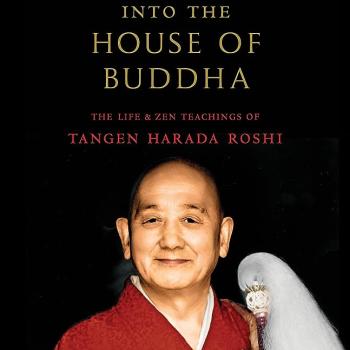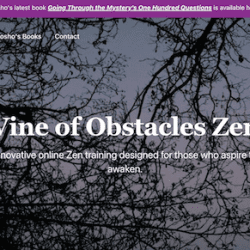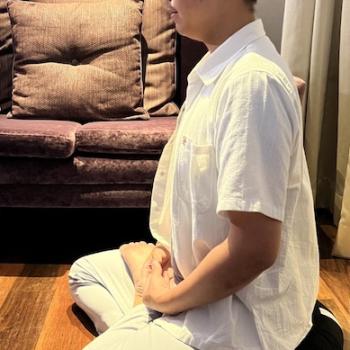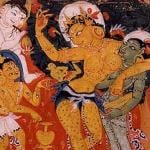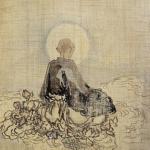There are a lot of cottonwood trees in my neighborhood and in this dry weather it is still snowing cottonwood fuzz. In the photo, my son is adapting to the circumstances to get the job done.
And that’s what we Western Buddhists are doing too – cutting through the the fuzz to find the straight-up Buddhadharma. Seems to me that’s a normal thing at this stage of our development and happened at least in China and Japan too. And maybe this is the healthiest period – inquiring mind is more easily open and cooking, especially important for practitioners who yearn for the real deal.
In that regard, in a comment to a recent post here, Harry brings up the issue of oneness and mindfulness. The question I hear in his comments is “What is correct practice, to focus on what we’re doing or maintain an open, oneness mind?”
The underlying issue lies in the nature of mindfulness to divide the world into two, the seen and the seer, for example. Even the great Theravadan master, Buddhagosa, recognized that mindfulness is the practice of suffering.
For those interested in the nondual dharma, freedom from the world of separation and alienation, this practice doesn’t taste so good, philosophically, at least.
The question is very close to the found koan that haunted me in the early years of my practice, “How do I go beyond self-consciousness,” and continues to unfold twenty-five years after initial resolution. See Keep Me in Your Heart Awhile: The Haunting Zen of Dainin Katagiri for more.
Harry cites an essay by Mike Eido Luetchford, a Nishijima successor, “One Moon or Two Moons – Oneness and Mindfulness in the Teaching of Zen Master Dogen.”
Now there is much in this essay that I appreciate and agree with. Luetchford’s parsing of what is often translated as mindfulness (smirti and the related, nen and shin) is especially good stuff. He also makes an important point about how mindfulness for Dogen and company was not a private mental experience but more about remembering the dharma in action, harmonizing body, speech, and thought.
Luetchford’s central point seems to be this: “It is clear that Dogen taught that the Buddhist state is a state in which there is no second person monitoring the actions of the body…. The Chinese masters and Dogen urge us to get rid of this second person.”
From my perspective, this does not resolve the issue of oneness and duality because it is also two – the second person (i.e., the witness consciousness or bystander in Zen language) is split off, gotten rid of. Where does the second person go?
After struggling for several years with how to go beyond self-consciousness, Katagiri Roshi said to me, “Already you are stuck.”
In my view, that points directly to another kind of resolution of the issue, one at peace with the witness consciousness too, a nondualism that warmly embraces dualism without any separation whatsoever. This is a warmhearted nondualism that is also very functional.
It echoes the Buddha saying repeatedly in The Four Foundations of Mindfulness, “the body in the body, the feeling in the feeling, the dharma in the dharma.”
Actualizing this is coincident with the insight. There is nothing to add or take away.
Dogens puts it this way:
Harmonizing and purifying yourself in this manner, do not lose either the one eye [of transcendent wisdom] or the two eyes [of discriminating consciousness]. Lifting a single piece of vegetable, make [yourself into] a six-foot body [i.e. a buddha] and ask that six-foot body to prepare a single piece of vegetable. (Tenzo Kyokun)
Continuously perform as such and you will be such a person. Your treasure-store will open of itself and you will joyfully use it at will. (Fukanzazengi)


